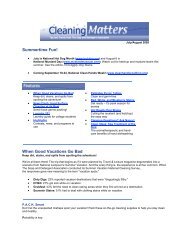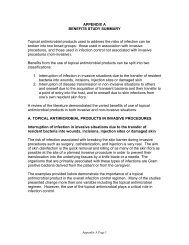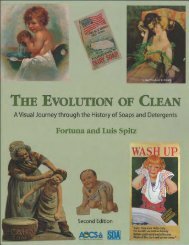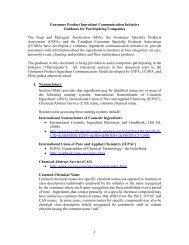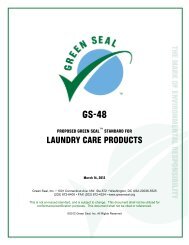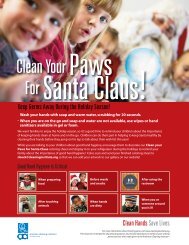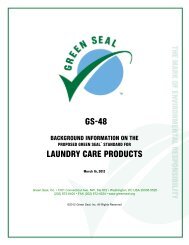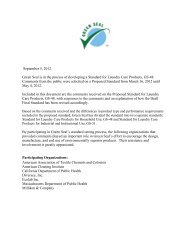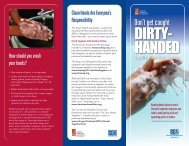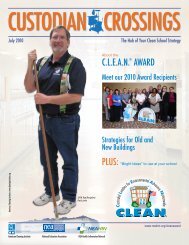subchapter c -- federal hazardous substances act regulations
subchapter c -- federal hazardous substances act regulations
subchapter c -- federal hazardous substances act regulations
You also want an ePaper? Increase the reach of your titles
YUMPU automatically turns print PDFs into web optimized ePapers that Google loves.
foam and on grass. No other data are available<br />
to show that this dynamic test is reliable.<br />
(2) In addition, even if the AFSL standard<br />
is effective, the Commission does not believe<br />
that compliance with the standard will be<br />
adequate. AFSL reports that it has been testing<br />
in accordance with its standard since January<br />
1994. However, the results of CPSC’s<br />
compliance testing indicate that multiple-tube<br />
devices still tip over while functioning. In<br />
fiscal year 1994, all 24 imported devices the<br />
Commission tested, and 1 of 8 domestic<br />
devices, tipped over while functioning. In<br />
fiscal year 1995, 22 of 27 imported devices<br />
and 1 of 5 domestic devices tipped over during<br />
Commission testing. The Commission finds<br />
that there is unlikely to be substantial<br />
compliance with the voluntary standard<br />
applicable to multiple-tube devices.<br />
(C) Relationship of benefits to costs. The<br />
Commission estimates that the 60-degree tipangle<br />
standard will eliminate the unreasonable<br />
tip-over risk posed by these devices. This will<br />
provide benefits of saving one life about every<br />
3 years, and preventing an unknown number<br />
of nonfatal injuries. The annual cost of<br />
modifying affected devices is estimated to be<br />
between $1.5 million and $2.7 million. The<br />
Commission finds that the benefits from the<br />
regulation bear a reasonable relationship to its<br />
costs.<br />
(D) Least burdensome requirement. The<br />
Commission considered the following<br />
alternatives: a ban of all multiple-tube devices<br />
with inner tube diameters 1.5 inches or greater;<br />
a dynamic performance standard; additional<br />
labeling requirements; and relying on the<br />
voluntary standard. Although a ban of all large<br />
multiple-tube devices would address the risk<br />
of injury, it would be more burdensome than<br />
the tip-angle standard. The Commission was<br />
unable to develop a satisf<strong>act</strong>ory dynamic<br />
standard that would reduce the risk of injury.<br />
Neither additional labeling requirements nor<br />
reliance on the voluntary standard would<br />
adequately reduce the risk of injury. Thus, the<br />
Commission finds that a standard requiring<br />
large multiple-tube devices to have a minimum<br />
tip angle greater than 60 degrees is the least<br />
burdensome requirement that would prevent or<br />
adequately reduce the risk of injury.<br />
(13)(i) Candles made with metal-cored<br />
wicks. Candles manuf<strong>act</strong>ured or imported on<br />
16 CFR Ch. II (1–1–05 Edition)—proposed modificication – 6/25/06<br />
-- 25 --<br />
or after October 15, 2003, made with metalcored<br />
candlewicks, unless:<br />
(A) The metal core of each candlewick has<br />
a lead content (calculated as the metal) of not<br />
more than 0.06 percent of the total weight of<br />
the metal core; and<br />
(B) Each outer container or wrapper in<br />
which candles subject to paragraph<br />
(a)(13)(i)(A) of this section are shipped,<br />
including each outer container or wrapper in<br />
which such candles are distributed to a retail<br />
outlet, is labeled “Conforms to 16 CFR<br />
1500.17(a)(13).” For purposes of this<br />
paragraph (B), the term “outer container or<br />
wrapper” does not include the immediate<br />
container in which candle(s) is/are intended to<br />
be displayed at retail or during use in the<br />
home, unless that container or wrapper is also<br />
the only container or wrapper in which the<br />
candle(s) is/are shipped to a retailer.<br />
(ii) Metal-cored candlewicks. Metalcored<br />
candlewicks manuf<strong>act</strong>ured or imported on or<br />
after October 15, 2003, unless:<br />
(A) The metal core of each candlewick has<br />
a lead content (calculated as the metal) of not<br />
more than 0.06 percent of the total weight of<br />
the metal core; and<br />
(B) Each outer container or wrapper in<br />
which candlewicks subject to paragraph<br />
(a)(13)(ii)(A) of this section is shipped,<br />
including each outer container or wrapper of a<br />
shipment distributed to a retail outlet, is<br />
labeled “Conforms to 16 CFR<br />
1500.17(a)(13).” For purposes of this<br />
paragraph (B), the term “outer container or<br />
wrapper” does not include the immediate<br />
container in which candlewick(s) is/are<br />
intended to be displayed or sold at retail,<br />
unless that container or wrapper is also the<br />
only container or wrapper in which the<br />
candlewick(s) is/are shipped to a retailer.<br />
(iii) Findings — (A) General. To issue a<br />
rule under section 2(q)(1) of the FHSA, 15<br />
U.S.C. 1261(q)(1), classifying a substance or<br />
article as a banned <strong>hazardous</strong> substance, the<br />
Commission must make certain findings and<br />
include them in the regulation. These findings<br />
are discussed in paragraphs (a)(13)(iii)(B)<br />
through (D) of this section.<br />
(B) Voluntary Standard. One alternative to<br />
the ban that the Commission considered is to<br />
take no mandatory <strong>act</strong>ion, and to depend on a<br />
voluntary standard. One organization has a<br />
standard for candlewicks intended to address



